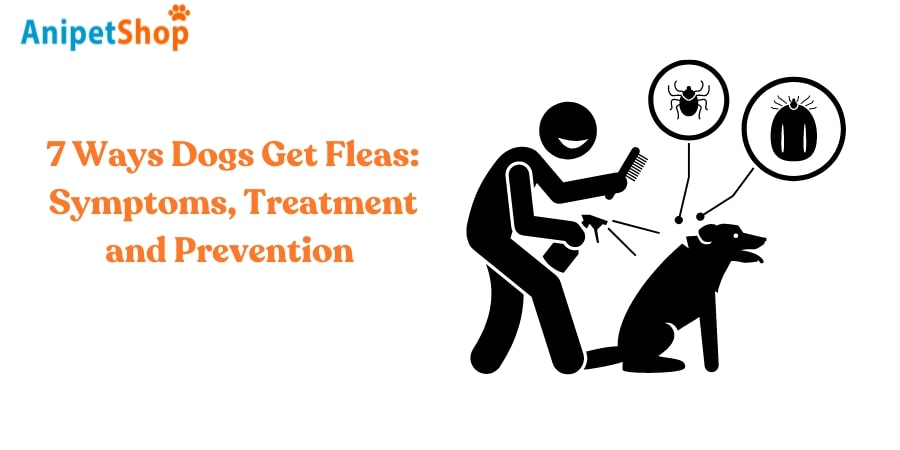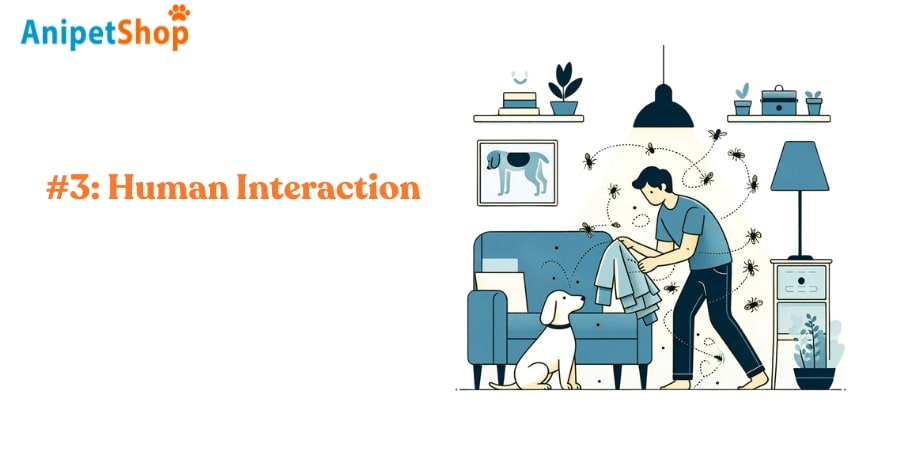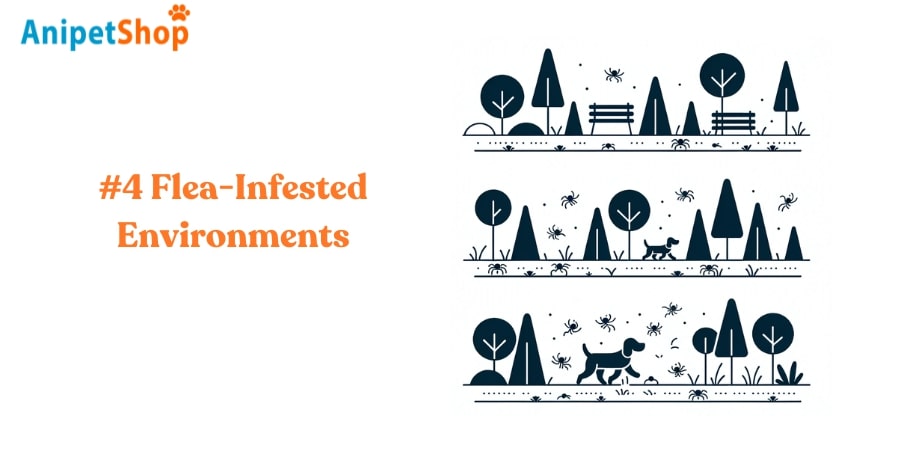7 Ways Dogs Get Fleas: Symptoms, Treatment and Prevention
Fleas pose significant dangers to dogs, including severe itching, skin infections, and the transmission of diseases such as tapeworms and flea allergy dermatitis. These small, wingless insects feed on the blood of their hosts, causing discomfort and potentially leading to more serious health issues if left untreated. Understanding the ways in which fleas can infest dogs is crucial for effective prevention and treatment. Fleas can latch onto dogs through contact with other infested animals or environments, making regular grooming, use of flea prevention products, and maintaining a clean living area essential for protecting pets from these persistent pests.

7 Ways Your Dogs Can Get Fleas
Living and playing outdoor during a long while makes your pets easily get fleas, and there are 7 most common reasons for getting fleas in your dogs:
#1: Direct Contact with Other Animals
Direct contact with other animals, whether it’s during playtime at the park or encounters with wildlife, presents a prime opportunity for fleas to hop from one host to another. When dogs interact closely with infested animals, especially those already carrying fleas, these tiny parasites can easily transfer onto your pet’s fur and find a new home to feed and reproduce. To address this, pet owners should remain vigilant by regularly inspecting their dogs for signs of fleas, such as excessive scratching or visible dark specks in the fur, which could indicate flea dirt. Avoiding contact with known infested animals and keeping pets on a leash during outdoor excursions can help reduce the risk of direct flea transmission. Additionally, using veterinarian-recommended flea prevention products, such as topical treatments or oral medications, provides an extra layer of defense against these pesky parasites, ensuring your dog stays healthy and flea-free.

#2: Flea Eggs and Larvae in the Home
Flea eggs and larvae in the home can lead to your dogs getting fleas when the eggs hatch and the larvae mature into adult fleas. These eggs and larvae can be present in carpets, bedding, furniture, and other areas where your dog spends time. To address this issue, regular vacuuming and washing of bedding with hot water can help eliminate flea eggs and larvae. Additionally, using flea control products such as sprays or powders specifically designed for household use can further prevent infestations. Regular grooming of your dog and treating them with veterinarian-approved flea prevention products can also significantly reduce the risk of flea infestations originating from the home.

#3: Human Interaction
Dogs also may unintentionally pick up fleas from humans. For example, persons who have visited infested places or come into contact with other animals carrying fleas may have fleas on their clothing or other things. Vacuum and clean living spaces often, wash and treat pet bedding and possessions on a regular basis, and think about using flea prevention solutions on pets and in the house to avoid this. Furthermore, meticulous pet grooming and examination following any exposure might aid in the early detection and elimination of fleas.

#4: Flea-Infested Environments
“Flea-infested environments” refers to places where fleas thrive and can easily transfer onto dogs. These environments include areas frequented by other infested animals, such as parks or wooded areas, where dogs may come into contact with fleas from wildlife like squirrels or raccoons. The solution involves minimizing exposure by avoiding known infested areas, keeping grass and shrubbery trimmed in your yard, and using flea repellents or treatments recommended by veterinarians before venturing into such environments. Regular grooming and inspection for fleas after outings can also help detect and address any infestations early.

#5: Dog facilities
The close closeness of several animals might unintentionally harbor fleas in dog facilities, such as boarding kennels or grooming salons. Fleas are easily spread from dog to dog in these settings if they are not kept up and cleaned. Dog facilities must establish strict cleaning procedures, such as routine vacuuming, bedding washing, and flea control product use, in order to handle this problem. In order to guarantee a flea-free environment for their pets, pet owners should also ask about the facility’s flea prevention practices prior to committing their dogs.

#6: Outdoors
If your dogs spend time outdoors, they are at risk of getting fleas from various sources such as contact with other infested animals, wildlife, or flea-infested environments like parks or yards. To address this, you can regularly treat your outdoor environment with flea control products, such as sprays or granules specifically designed for outdoor use. Additionally, consider creating a barrier around your yard using flea-repelling plants like lavender or mint, and regularly mow your lawn to keep it short, as fleas thrive in tall grass. Regularly inspect your dogs for fleas after outdoor activities and promptly remove any pests you find.

#7: Warmer climates
In warmer climates, fleas thrive due to the conducive environmental conditions. Higher temperatures and humidity create ideal breeding grounds for fleas, making it easier for dogs to become infested. The solution to this issue involves implementing comprehensive flea prevention measures. This includes regular use of flea prevention products recommended by veterinarians, frequent grooming to detect and remove fleas early, keeping the living environment clean through vacuuming and washing bedding regularly, and consulting with a veterinarian for additional advice or treatments tailored to the specific needs of the dog and its environment.

Symptoms when your dog get fleas
Similar to several other insects, fleas go through a convoluted life cycle that has four primary stages: the egg, larva, pupa, and adult. When adult fleas, which are often located on the host animal (such as a dog), lay eggs, the cycle usually starts. These tiny, oval-shaped eggs frequently break off their host and land in the dog’s bedding, on the carpet, or in the yard.
Because fleas reproduce quickly, even a small infestation can grow rapidly if left untreated. As a result, it’s imperative that dog owners watch out for any indications of flea infestation. Among these indicators are:
- Excessive scratching, biting, or licking of the skin, particularly in areas where fleas tend to congregate, such as the base of the tail, groin, or underarms.
- Redness, irritation, or inflammation of the skin, often accompanied by small bumps, scabs, or hot spots.
- Presence of flea dirt, which appears as dark specks or flakes in the dog’s fur or on the skin. Flea dirt is actually flea feces consisting of digested blood and is a common indicator of flea infestation.
- Allergic reactions in some dogs, characterized by hair loss, inflamed skin, and intense itching (flea allergy dermatitis).
- Occasionally, the presence of adult fleas themselves may be visible on the dog’s fur, especially if the infestation is severe. Adult fleas are small, dark brown insects that move quickly through the fur.
Identifying these signs early is essential for effective flea control and prevention measures to protect both the dog and its environment from infestation.

Prevention and Treatment
Dog flea infestations must be prevented and treated using a multifaceted strategy in order to successfully eradicate fleas and stop them from returning. Using veterinarian-recommended flea preventive solutions on a regular basis, including as flea collars, oral meds, and spot-on treatments, is part of prevention. Furthermore, keeping your home tidy by routinely cleaning bedding, vacuuming carpets, and treating outdoor spaces where fleas could breed can help lower the likelihood of an infestation. When dogs do have fleas, the usual course of treatment is to use products made especially to keep them flea-free, like flea shampoos, topical treatments, and oral meds. To guarantee secure and efficient care, it’s critical to carefully read product labels or the directions given by veterinarians. In order to deeply understand how to prevent your dogs from fleas and which treatment is suitable for them, you should refer to our detailed instructions.
Conclusion
In conclusion, pet owners must be aware of the different ways that flea infestations can occur in order to properly safeguard their furry friends from these bothersome parasites. When symptoms of a flea infestation are identified, such as frequent scratching, flea filth, and adult fleas that are visible, treatment can be started right away to reduce discomfort and stop the infestation from spreading. Managing flea infestations and protecting dogs’ health and wellbeing need a combination of preventative strategies, such as routinely using flea prevention medications prescribed by veterinarians, keeping a clean living environment, and getting quick medical care when necessary. Pet owners can reduce the possibility of flea-related health problems and maintain their dogs’ happiness and itching by being watchful and proactive.
Lily Watson is an author specializing in veterinary care in Australia. With a profound passion for animal welfare and a solid foundation in veterinary science, Lily has dedicated herself to disseminating valuable knowledge and information for both pet owners and professionals in this field.

